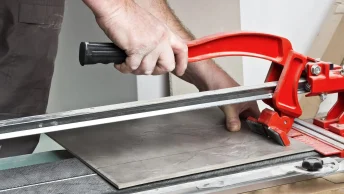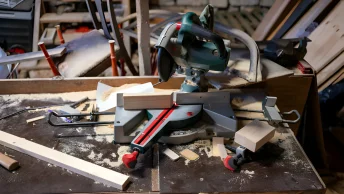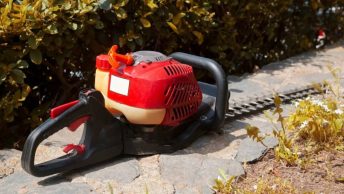Chainsaw is a powerful tool that makes cutting trees, firewood and other tasks easier. It consists of a motor that powers a chain attached to a guide bar.
But with so many sizes and types of chainsaw available in the market, one question always arises about chainsaw is what size do I need?
In this article, we will discuss the factors that determine what size of chainsaw is suitable for your needs.
Define Chainsaw:
Chainsaw size refers to the length of the guide bar and is usually measured in inches.
The longer the guide bar, the bigger the chainsaw size. For example, a 16-inch chainsaw has a guide bar that is 16 inches long.
The size of a chainsaw is significant as it determines the types of tasks it can handle efficiently.
Key components:
The main components of a chainsaw that affect its size are the engine, guide bar, and chain.
The size of these components directly affects the overall size and weight of the chainsaw.
Engine size and power output:
The engine is the heart of a chainsaw and plays a crucial role in determining its size.
The engine’s power output is measured in cubic centimetres (cc) and is directly related to the size of the chainsaw.
The higher the cc, the more powerful the engine and the larger the chainsaw will be.
Guide Bar Length and its Impact on Cutting Capacity
The guide bar is responsible for holding and guiding the chain as it cuts through wood.
Its length determines how deep a chainsaw can cut in a single pass. Chainsaws with longer guide bars have a larger cutting capacity and can handle thicker logs and trees.
Chain size and its compatibility with the guide bar:
The chain is made up of sharp teeth that rotate around the guide bar, cutting through wood.
The chain’s size is directly related to the length of the guide bar and must be compatible for efficient cutting.

A longer guide bar requires a longer chain, and vice versa.
Factors to Consider When Determining What Size Chainsaw You Need:
There are several factors to consider when determining what size chainsaw is suitable for your needs.
These include the type of wood you will be cutting, the frequency of use and your physical capabilities.
- Type of wood: Harder and thicker wood requires a larger chainsaw with a longer guide bar.
- Frequency of use: If you plan on using the chainsaw frequently, it’s better to invest in a bigger size for efficiency and durability.
- Physical capabilities: Smaller chainsaws are lighter and easier to handle, making them suitable for those with less strength or physical limitations.
- Personal preference: Ultimately, the size of chainsaw you choose will depend on your personal preference and comfort level
- Budget: Larger chainsaws with bigger engines and longer guide bars tend to be more expensive, so consider your budget when making a decision.
- Safety: It’s crucial to choose a chainsaw size that you can handle safely to minimize the risk of accidents.
- Environmental considerations: If you are working in a residential area with noise restrictions, a smaller chainsaw may be more suitable.
- Type of work: Different tasks require different chainsaw sizes. For example, a smaller chainsaw may be sufficient for trimming and pruning trees, but a larger one is needed for felling trees or cutting up large logs.
- Experience level: If you are new to using a chainsaw, it’s best to start with a smaller size and work your way up as you gain experience.
Small Chainsaws
Small chainsaws are typically those with a guide bar length of 14 inches or less.
They are lightweight and easy to handle, making them suitable for tasks such as trimming and pruning trees, cutting small logs, and light firewood work.
Engine Size:
Small chainsaws usually have an engine size of 25cc or less, making them less powerful but also quieter and more fuel-efficient.
They are a great option for beginners and those with limited physical strength.
Benefits:
- Easy to handle: Small chainsaws are light and compact, making them easy to manoeuvre in tight spaces or overhead.
- Affordable: They are generally less expensive than larger chainsaws, making them a budget-friendly option.
- Convenient: Small chainsaws are portable and easy to transport, making them suitable for remote or off-site work.
- Low maintenance: With fewer parts and a smaller engine, small chainsaws require less maintenance compared to larger ones.
- Quiet operation: Smaller motors produce less noise, making them ideal for working in residential areas with noise restrictions.
Limitations:
- Limited cutting capacity: Due to their smaller guide bar length, small chainsaws are not suitable for heavy-duty tasks such as felling trees or cutting large logs.
- Not as durable: Smaller chainsaws may not be as durable as larger ones, making them more suitable for occasional use rather than heavy and frequent use.
Must check: Best Small Gas Chainsaw
Medium Chainsaw:
Medium chainsaws have guide bar lengths ranging from 14 to 20 inches, making them a versatile option for various cutting tasks.
They are suitable for both light and heavy-duty work.

Engine Size:
Medium chainsaws typically have an engine size of 35cc to 45cc, providing more power and torque compared to smaller chainsaws.
This makes them suitable for cutting thicker and harder wood.
Benefits:
- Versatile: Medium chainsaws can handle a wide range of tasks, from light yard work to more heavy-duty jobs.
- Efficient: With a larger guide bar and engine, medium chainsaws can make cuts faster and easier compared to smaller ones.
- Durable: These chainsaws are built to withstand frequent use and tough conditions, making them a reliable choice for professionals.
- Comfortable to use: The larger size and weight of medium chainsaws can provide more stability and reduce vibrations, making them comfortable to handle for longer periods.
Limitations:
- More expensive: Medium-sized chainsaws tend to be more expensive than small ones due to their bigger engines and guide bars.
- Heavier: The added power comes with a trade-off, as medium chainsaws are heavier and may be more tiring to use for some people.
Large Chainsaws:
Large chainsaws are those with a guide bar length of 20 inches or more. They are designed for heavy-duty tasks and can handle larger logs and trees with ease.
Engine size:
Large chainsaws typically have an engine size of 50cc or more, making them powerful enough to tackle tough cutting jobs.
However, this also means they are heavier and may require more physical strength to handle.
Benefits:
- Increased cutting capacity: With a longer guide bar and larger engine, large chainsaws can cut through thicker logs and trees.
- High power output: Large chainsaws have more horsepower, making them suitable for demanding tasks that require a lot of cutting force.
- Durable: These heavy-duty chainsaws are built to last and can handle frequent use without wearing down quickly.
- Suitable for professionals: Large chainsaws are commonly used by professional loggers, tree service companies, and other industries that require heavy cutting.
Limitations:
- Heavy and bulky: Due to their size and power, large chainsaws can be heavier and more challenging to handle than smaller ones.
- High maintenance: With more parts and a larger engine, these chainsaws may require more frequent maintenance and repair.
- More expensive: Large chainsaws are generally more expensive than smaller ones, making them less accessible for occasional users or those on a tight budget.
What Size Chain Do I Need for My Chainsaw Step-by-Step Guideline?

When determining the size of chain you need for your chainsaw, there are a few steps to follow:
- Check the manufacturer’s specifications: The first step is to check the owner’s manual or contact the manufacturer to find out what size chain is recommended for your specific chainsaw model.
- Measure the guide bar length: Using a tape measure, measure the length of your chainsaw’s guide bar from the tip to the point where it enters the chainsaw body. This measurement will determine the length of chain you need.
- Count the drive links: The number of drive links on your chain must match the number specified by the manufacturer for your chainsaw model. Drive links are metal pieces that fit into the groove of the guide bar and move the chain around.
- Determine the gauge: The gauge refers to the thickness of your chainsaw’s drive links. Most chainsaws have a gauge of 0.050 or 0.063 inches, but it’s crucial to check the specifications for your particular model.
- Choose the right pitch: The pitch is the distance between any three consecutive rivets on the chain. It’s typically measured in inches, and common sizes include 0.325, 3/8, or 0.404 inches.
By following these steps and choosing the correct size of chain for your chainsaw.
Must check: Poulan chainsaw Wont Start
Maintenance and Safety Tips:
No matter the size of your chainsaw, proper maintenance and safety precautions are essential to ensure its longevity and prevent accidents.
Here are a few tips to keep in mind:
- Regularly clean and inspect your chainsaw for any damage or wear.
- Keep the chain sharp by sharpening it regularly with a file or taking it to a professional.
- Refuel correctly and avoid using old or contaminated fuel.
- Wear protective gear, including gloves, eye and ear protection, and chainsaw chaps.
- Always follow the manufacturer’s instructions for starting, operating, and maintaining your chainsaw.
By following these tips, you can ensure that your chainsaw remains in good condition and is used safely.
Conclusion:
Chainsaws come in a variety of sizes, each with its own unique benefits and limitations. From small to medium to large chainsaws, there is an option suitable for every type of cutting task.
Remember to always choose the appropriate size and follow safety precautions when using a chainsaw.
Proper maintenance will also ensure that your chainsaw remains in good working condition for years to come. So, keep these tips in mind and make the most out of your chainsaw! So, whether you’re a professional or an occasional user, a suitable size of chainsaw can help you get the job done efficiently and safely.
With proper care and maintenance, your chainsaw will continue to serve you for many cutting tasks to come.




